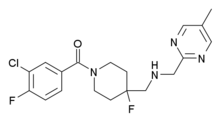F-15,599
F-15,599, also known as NLX-101, is a potent and selective 5-HT1A receptor full agonist.[1][2] It displays functional selectivity (also known as "biased agonism") by strongly activating 5-HT1A receptors in the postsynaptic prefrontal cortex while having little effect on somatodendritic autoreceptors in the raphe nucleus.[1][2] As a result, it has been touted as a preferential postsynaptic 5-HT1A receptor agonist and has been investigated as a novel potential antidepressant.[1][2][3]
 | |
| Clinical data | |
|---|---|
| Routes of administration | Oral |
| Legal status | |
| Legal status |
|
| Identifiers | |
| |
| PubChem CID | |
| IUPHAR/BPS | |
| ChemSpider | |
| Chemical and physical data | |
| Formula | C19H22ClF2N4O |
| Molar mass | 395.86 g·mol−1 |
| 3D model (JSmol) | |
| |
| |
| | |
In cognitive tests in rodent, F-15,599 attenuates memory deficits elicited by the NMDA receptor antagonist PCP, suggesting that it may improve cognitive function in disorders such as schizophrenia.[4]
A subsequent study showed that F-15,599 reduces breathing irregularity and apneas observed in mice with mutations of the MeCP2 gene.[5] Dysruption of MeCP2 gene expression underlies Rett syndrome, a debilitating neurodevelopmental orphan disease.
F-15,599 was discovered and initially developed by Pierre Fabre Médicament, a French pharmaceuticals company. In September 2013, F-15,599 was out-licensed to Neurolixis, a California-based biotechnology company. Neurolixis announced that it intends to re-purpose F-15,599 for the treatment of Rett syndrome.[6] and obtained Orphan Drug designation from the United States Food and Drug Administration (FDA)[7] and from the European Commission for this indication.[8]
Researchers at the University of Bristol are investigating the activity of F-15599 in animal models of Rett Syndrome, with support from the International Rett Syndrome Foundation.[9] In June 2015, the Rett Syndrome Research Trust awarded a grant to Neurolixis to advance F-15599 to clinical development.[10]
See also
- Befiradol (F-13,640)
- Eptapirone (F-11,440)
References
- Maurel JL, Autin JM, Funes P, Newman-Tancredi A, Colpaert F, Vacher B (October 2007). "High-efficacy 5-HT1A agonists for antidepressant treatment: a renewed opportunity". Journal of Medicinal Chemistry. 50 (20): 5024–33. doi:10.1021/jm070714l. PMID 17803293.
- Newman-Tancredi A, Martel JC, Assié MB, et al. (January 2009). "Signal transduction and functional selectivity of F15599, a preferential post-synaptic 5-HT1A receptor agonist". British Journal of Pharmacology. 156 (2): 338–53. doi:10.1111/j.1476-5381.2008.00001.x. PMC 2697830. PMID 19154445.
- Assié MB, Bardin L, Auclair AL, et al. (November 2010). "F15599, a highly selective post-synaptic 5-HT(1A) receptor agonist: in-vivo profile in behavioural models of antidepressant and serotonergic activity". The International Journal of Neuropsychopharmacology. 13 (10): 1285–98. doi:10.1017/S1461145709991222. PMID 20059805.
- Depoortère R, Auclair AL, Bardin L, Colpaert FC, Vacher B, Newman-Tancredi A (September 2010). "F15599, a preferential post-synaptic 5-HT1A receptor agonist: activity in models of cognition in comparison with reference 5-HT1A receptor agonists". European Neuropsychopharmacology. 20 (9): 641–54. doi:10.1016/j.euroneuro.2010.04.005. PMID 20488670.
- Levitt ES, Hunnicutt BJ, Knopp SJ, Williams JT, Bissonnette JM (December 2013). "A selective 5-HT1a receptor agonist improves respiration in a mouse model of Rett syndrome". Journal of Applied Physiology. 115 (11): 1626–33. doi:10.1152/japplphysiol.00889.2013. PMC 3882741. PMID 24092697.
- http://neurolixis.com/images/stories/nlx_pf_license_23sept13.pdf%5B%5D
- http://www.accessdata.fda.gov/scripts/opdlisting/oopd/OOPD_Results_2.cfm?Index_Number=410613%5B%5D
- http://ec.europa.eu/health/documents/community-register/html/o1242.htm%5B%5D
- http://www.bristol.ac.uk/news/2014/april/rett-syndrome-research.html
- https://rettsyndrome.wordpress.com/2015/06/24/rsrt-awards-530000-to-neurolixis-for-clinical-development-of-nlx-101/